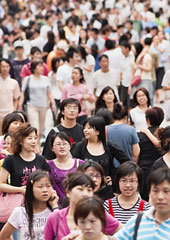China’s Urban Billion: Civilizing the Cities
Can China’s cities by 2030 really accommodate one billion residents — equal to one in every eight people on the planet?
February 23, 2013

How China’s cities look in 2030 will depend on whether Chinese leaders are willing to forgo short-term economic gains and make the changes needed to create a healthier form of urbanization. One in three people living in China’s cities today are not treated as equal citizens.
If China does not begin to untie migrant workers’ social security entitlements from their hukou status, the proportion of disenfranchised urban residents will continue to grow.
By 2030, almost half of China’s billion urban citizens could effectively belong to a giant underclass, without proper housing or access to basic public services. The potentially explosive political ramifications of this bleak societal picture mean that some reform is unavoidable.
The big question is whether the central government has the political will to address the roots of the problem. This will be a central concern for the new administration under President Xi Jinping and Premier Li Keqiang to address.
So far, most of the reforms have occurred at the local level. But while pilot-style land and hukou reforms in a number of cities and provinces represent some progress, they have also confirmed fears about the inherent dangers of those reforms.
Still, attempts in Chongqing and Chengdu to break down the urban-rural apartheid by relaxing hukou restrictions and firming up rural property rights are broadly positive moves, even though there is evidence of forced hukou conversions and illegal land grabs.
These experiments are a necessary stage on the path to reform, even if they do have some unpleasant consequences. Seeing what works and what does not work is precisely their point.
By 2030, Chinese policymakers should aim to grant all urban residents full social security and turn hukou into a simple family registration system, as it is in Taiwan and Japan. The proposal by the Ministry of Public Security to extend local residence permit schemes, which offer limited social benefits to migrant workers, is another small step in the right direction.
Local hukou reforms have been slow and piecemeal, but there is some noteworthy progress. More migrant children are receiving a state education and more of their parents are enrolled in social insurance programs.
The most encouraging new social policy in recent years is the national plan to build millions of units of subsidized public, or “social,” housing. This could potentially change the lives of China’s urban poor. But the initial evidence suggests that most new units will go to local residents. Few will be available to migrant workers without local hukou.
As municipal governments demolish the thousands of slum villages that riddle China’s cities, they must replace them with rental housing that migrant workers can afford.
So far, China’s urbanization process has not generated the kind of massive slums that blight other developing cities around the world. But as more rural migrants bring their families to the city, and as these people begin to settle permanently, China’s cities will struggle to avoid this horror.
Despite investors’ fears about China’s supposed housing surplus, the more acute problem is China’s housing shortage. More than 200 million migrant workers are currently excluded from China’s housing market. As Chinese cities become more prosperous, these people should move out of slums and into social housing.
Yet subsidized housing is not a silver bullet. Cities with aggressive urbanization policies, such as Chongqing, need to beware herding millions of farmers into cities who have few, if any, useful urban skills.
Long-term migrants know how to survive in the city, but many farmers will struggle. The fear is that they will end up living, unemployed and on benefits, in vast housing estates.
This gloomy path is well trodden in the Western world: the United States has its drug-infested “projects,” the United Kingdom has its “sink” council estates and France its rundown banlieues.
But China’s policymakers have given little thought to the social canker that can fester among disadvantaged communities in public housing, especially where there is social discrimination and a shortage of jobs.
Cash-strapped cities
In China, the emphasis is on replacing decrepit housing with modern apartment blocks. But without very good management, towers of shoddily built flats peopled by hopeless ex-farmers could deteriorate quickly.
A more immediate concern is how cash-strapped cities will pay for all this new housing, not to mention the cost of integrating millions of migrants into city life. If ambitious local hukou reforms such as those in Chongqing are extended nationwide, the financial pressure will be intense.
At the moment, local governments rely on land sales to plug their funding shortages. But this cannot be a long-term solution to the problem. China only has limited farmland and there is no guarantee that land prices will rise quickly enough to replenish local coffers.
China must also consider the environmental impact of creating sprawling cities, especially as they will inevitably become clogged with millions of private cars. China is not America: it simply does not have enough land for every household to own its own vehicle.
As the urban population grows ever larger, China must learn to accommodate people in highly concentrated cities that use limited resources efficiently.
If local governments cannot rely on selling land to shore up rickety local finances, how will they pay for social housing, public services and city infrastructure? The answer is that the central government must shoulder its fair share of the spending burden. Local governments currently finance nearly all public services, including 80% of basic health and education expenditures.
Since a large slice of locally collected taxes goes into central government coffers, most local authorities struggle to meet their financial responsibilities. By contrast, the central government is swimming in cash. Increasingly, the challenge facing China is not a lack of funds as such, but how to channel them to the right places and to the right people.
Abandoning collectivist land ownership, dismantling the current hukou system and redesigning the country’s fiscal system will require enormous political courage. So far, China’s leaders have not shown the stomach to press ahead with such reforms.
We can only hope that the new leadership team, which is set to hold power over the coming decade, will have more courage. The alternative is for China to become a kind of giant Latin America — a country with pockets of extreme wealth and an educated middle class, but whose cities teem with enormous slums and entrenched social divisions.
If China’s cities are truly to accommodate one billion residents — one in every eight people on the planet — its leaders must find a healthier, more inclusive and, ultimately, sustainable model of urban development. Only then will China’s cities be truly civilized.
Editor’s note: This essay is adapted from China’s Urban Billion: The Story Behind the Biggest Migration in Human History (Zed) by Tom Miller. Published by arrangement with the author and Zed Books. Copyright © 2012 by Tom Miller.
Takeaways
By 2030, almost half of China's billion urban citizens could effectively belong to a giant underclass.
While investors fear China's supposed housing surplus, the more acute problem is China's housing shortage.
China is not America: it simply does not have enough land.
The challenge facing China is not a lack of funds, but how to channel them to the right places and to the right people.
China should turn the hukou system into a simple family registration system, as it is in Taiwan and Japan.

